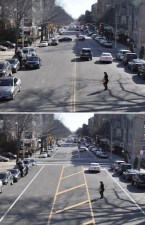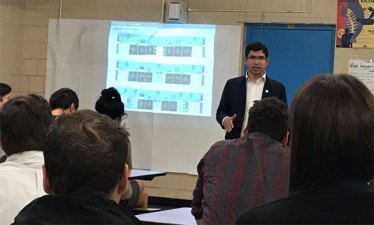Pedestrian Injuries Down 61% on Fourth Avenue in Park Slope After Road Diet
![DOT text. Image: DOT [PDF]](http://www.streetsblog.org/wp-content/uploads/2015/04/4th_ave_DOT.png)
As in Sunset Park, the Fourth Avenue road diet has yielded impressive street safety dividends for Park Slope, including a 61 percent drop in pedestrian injuries. Now, DOT is moving forward with plans to cast its changes in concrete.
Between Atlantic Avenue and 15th Street, the road diet widened medians, shortened crossing distances, and trimmed the number of car lanes from three in each direction to two along most of the street (the northernmost blocks retained the same number of lanes). The changes were implemented using paint and flexible bollards.
After the redesign, pedestrian injuries on this stretch of Fourth Avenue fell 61 percent, total crashes dropped 20 percent, and crashes with injuries were reduced by 16 percent, according to DOT, which compared one year of post-implementation crash data to the prior three-year average [PDF]. The improvements were especially dramatic at 3rd Street, where crashes fell 41 percent, and at 9th Street, where they fell 59 percent.
DOT also tracked speeding after 9 p.m. on weekdays, with the prevalence of drivers traveling above 35 mph falling by about three-quarters, from 29 percent of southbound drivers before the road diet to just 7 percent after. (The drop in the citywide default speed limit from 30 to 25 mph took effect days after DOT finished collecting its data last year.)
Car traffic levels and travel times stayed mostly steady, with southbound evening volumes falling slightly and mixed results for northbound morning volumes. Pedestrian volumes also held steady.
DOT is now proposing to build out the changes in permanent materials, installing a raised median that offers room for tree plantings and protects subway vents from flooding. Benches will be added in the median at pedestrian crossings. Curb extensions will also be added to the south corners of Fourth Avenue and Prospect Avenue, and the sidewalk will be widened on Fourth Avenue between 34th Street and 36th Street, on the side next to Green-Wood Cemetery.
While extra-wide parking lanes added to Fourth Avenue have given some breathing room to cyclists, they also provide space for double-parked cars. Casting the existing design in concrete could make it more difficult to add protected bike lanes to the street in the future.
The project will be built in phases, some of which are not yet funded. The first phase covers two sections, between 8th Street and 18th Street in Park Slope and between 33rd Street and 52nd Street in Sunset Park. These segments received federal funding, and construction is set to begin in spring 2017.
The second phase would bridge the gap from 18th to 33rd Streets, with construction projected to begin in spring 2018. The final phases, which run from 8th Street north to Atlantic Avenue and 52nd Street south to 65th Street, are not funded.
Fourth Avenue is part of the de Blasio administration’s Vision Zero Great Streets initiative, which is distributing $250 million in capital funding to the reconstruction of dangerous arterials. Of that funding, $100 million is going to Queens Boulevard. Fourth Avenue will share the remaining $150 million with the Grand Concourse and Atlantic Avenue.
DOT presented the data and its capital project plans to the Brooklyn Community Board 6 transportation committee last Thursday. There was a unanimous vote in support of the plan, but not enough board members to constitute a quorum. A recommendation to support the capital project is likely to come up at the next CB 6 general board meeting on May 13.


